Nine Innings: The Cubs' Issue With Launch Angle, Reimagining Bullpen Roles and Jonny Venters's Painful Journey

KYLE SCHWARBER ADJUSTS SWING TO OPPOSE THE LAUNCH ANGLE REVOLUTION
By Tom Verducci
Here’s the kind of story you might be reading more about in the months to come: when the launch angle revolution goes too far.
We all are familiar with the many players who changed their swing to get more balls in the air and found new success, including Justin Turner, Yonder Alonso, J.D. Martinez, Chris Taylor, Daniel Murphy, et al. But too much launch angle? Yes, we will start hearing more about players who took the theory too far and adjusted back toward a more level path to the baseball.
This is the story of Cubs outfielder Kyle Schwarber. It may surprise you—and it certainly surprised Chicago executives, who upon drafting him, foresaw him putting up “Big Papi” numbers—to know that last year Schwarber was the worst fastball hitter in baseball.
The worst.
Schwarber hit .212 against four-seam and two-seam fastballs and sinkers, the worst batting average among any player with 200 such results.
Here is the list:
Worst Fastball Hitters in 2017
1. Kyle Schwarber, Cubs | .212 |
|---|---|
T2. Mike Napoli, Rangers | .214 |
T2. Darwin Barney, Blue Jays | .214 |
T4. Chris Davis, Orioles | .218 |
T4. Logan Forsythe, Dodgers | .218 |
What happened? Pitchers exploited the low hand position Schwarber used to hit. As the pitcher pulled the ball back to throw, Schwarber held his hands slightly above the waist. He couldn’t catch up to velocity above his hands. He exacerbated the issue by swinging with even more of an upward path than he used in 2015.
Schwarber made a key change this year, a change prompted in part by the emphasis from manager Joe Maddon in spring training to his hitters to worry less about launch angle and more about a level path and using the whole field. Now as the pitcher loads, Schwarber keeps his hands nearly shoulder level. As the pitch is released, he raises his hands before taking them down to the ball. His goal: don’t try to lift the baseball; be more direct to the ball.
How’s it working? Here is Schwarber last year and this year vs. fastballs:
| Batting Average | Slugging Percentage |
|---|---|---|
2017 | .212 | .469 |
2018 | .281 | .531 |
And now consider how far he has reduced his launch angle (2016, an injury-shortened season, is omitted) while putting more balls in play:
Schwarber Average Launch Angle and Strikeout Rate
| Degrees | Strikeout Percentage |
|---|---|---|
2015 | 16.0 | 28.2% |
2017 | 17.8 | 30.9% |
2018 | 8.0 | 22.9% |
Travis Shaw of Milwaukee is another hitter who has been tamping down his launch angle (since 2016: 16.1, 14.6, 11.9). This follows a familiar pattern with new ideas in baseball (defensive shifts, batting the pitcher eighth, accepting strikeouts on offense, etc.): people overdo it with the new toy.
Nobody wants to hit a groundball, but the quest to get the ball airborne does have its limits. Maddon, for one, made it clear he is no fan of using launch angle as a point of emphasis.
“The launch angle thing to me, it sounds sexy,” he said. “Some guys just do it naturally. But guys should almost have to wash out before they embrace it, almost like a lefty pitcher who has to learn to drop down [sidearm]. I think it’s more of an acquired taste, something for somebody who is in need of a different method. If you’re a corner player who may be hitting the ball hard but not showing power, maybe it’s something to try. But for the regular player, no. Taking a good, level pass at the ball still plays.”
BEST THING I SAW THIS WEEK: THE PADRES POWERFUL DUO YOU PROBABLY HAVEN'T HEARD OF
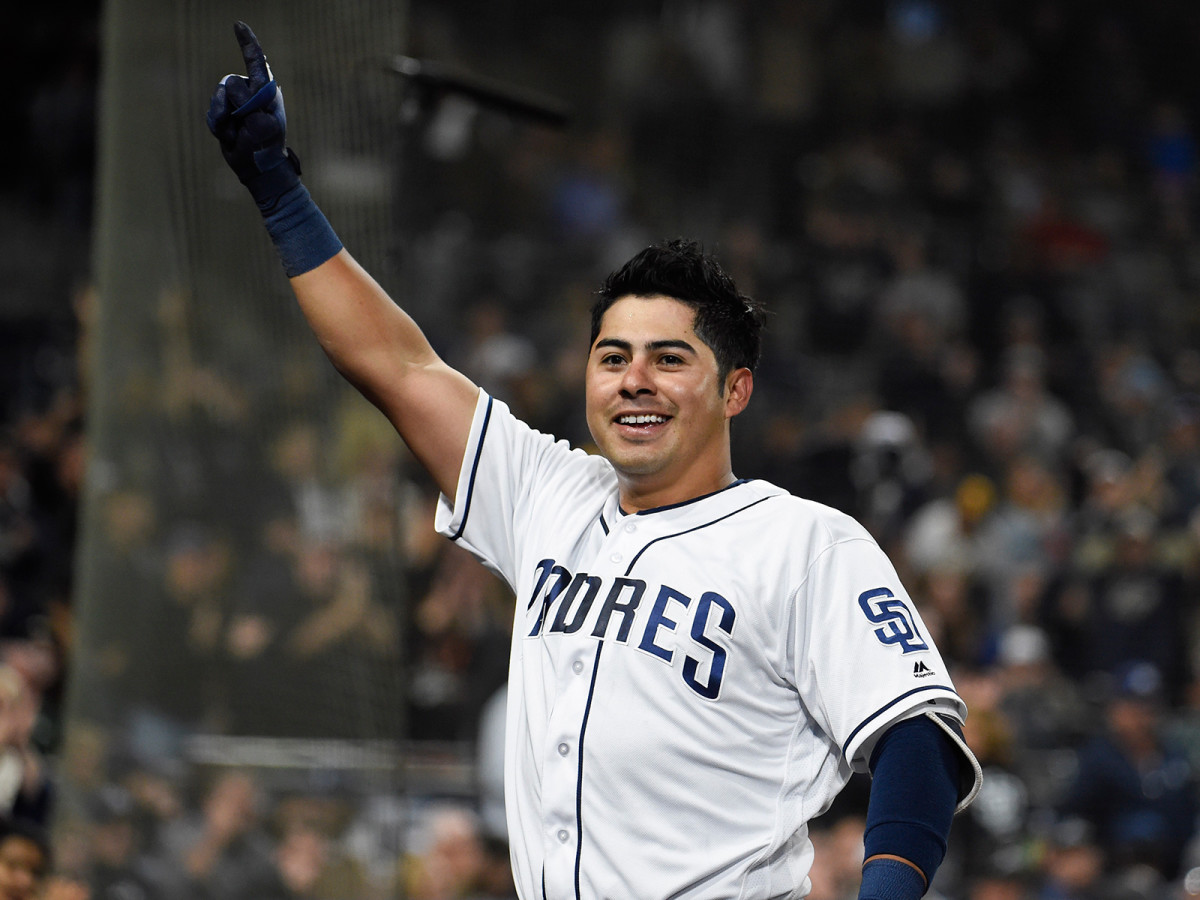
By Jack Dickey
Only a fool would claim that the 2018 Padres, in the aggregate, have been a surprise. The club won 71 games last year and 68 the year before that; at 10-19 through Sunday, San Diego is on pace to win all of 56 games this time around. They may not be fully that bad, but they boast the game’s second-lowest team OPS and lead the sport in strikeouts. With Freddy Galvis and Austin Hedges taking at-bats every day, Padres games aren't exactly appointment TV.
And yet, all that aside, two rookie Padres have been responsible for some of April’s most gobsmacking moments. Their names are Christian Villanueva and Franchy Cordero, and together they have combined for 14 home runs, same as the entire remainder of the NL’s rookie class. Villanueva has eight of them; Cordero has six. Is exit velocity your thing? It’s Cordero’s too. He ranks fourth in average exit velocity, according to Statcast, behind only Yoan Moncada, Nelson Cruz, and Aaron Judge. Meanwhile, Villanueva has been nothing short of the best hitter in the National League, by OPS.
On Saturday, facing Mets free-agent signee/future batting-practice pitcher Jason Vargas, Cordero and Villanueva put their stamp on the game together. Villanueva hit a two-run homer in the first inning, and three innings later, with two men on, Cordero did him one better, crushing one to right-center with an estimated distance of 459 feet. (The homer would be something to marvel at, except that Cordero hit one 489 feet a week prior.) The Padres won, 12-2.
Neither was ever much of a prospect—Villanueva, who will turn 27 in June, signed with San Diego after the 2016 season after seven so-so years in the Rangers’ and Cubs’ systems, and Cordero, who is only 23, tended to strike out too much in the minors for scouts’ liking—and indeed both may return to earth before the All-Star break. But for now, all that, like any of those 14 baseballs tattooed by the Padres’ fearsome twosome, is far off in the distance.
NUGGETS AND NOTES FROM THE SEASON'S FIRST MONTH
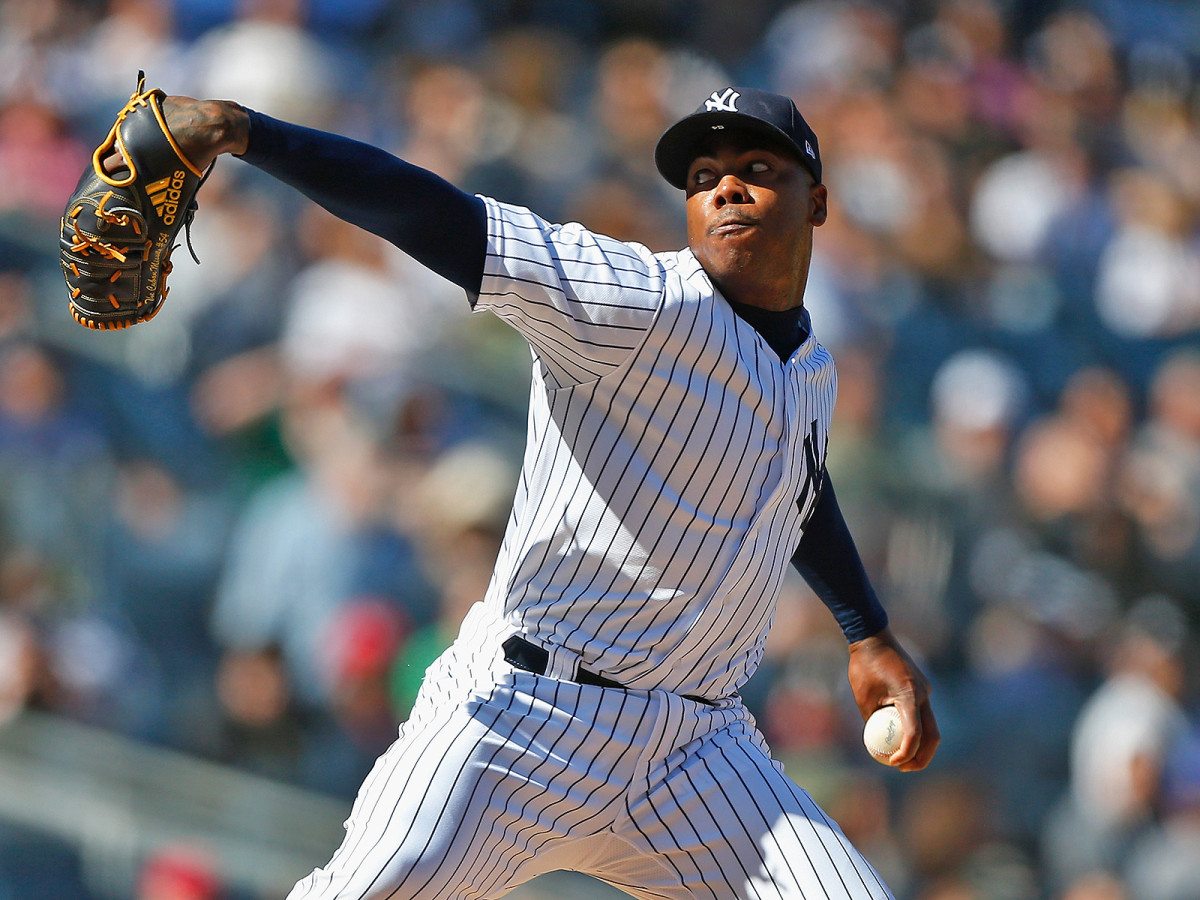
By Tom Verducci
Here are some quick takeaways from the first month of the season. Remember the grain of salt to add to these observations: the weather was terrible in most places. Let’s not consider these full-blown trends until we are watching baseball played without ski masks. Entering Sunday:
• Strikeouts continue on what has been an unabated record pace for more than a decade. We now have a game where, for the first time in history, strikeouts outnumber hits.
• There have been more strikeouts in April than in the entire 1924 season.
Red Sox Reliever Joe Kelly Takes in Game From Stands After Suspension
• When it comes to getting a hit, baseball has returned to the woes of the 1960s. With a .243 batting average, this month equaled the worst hitting in the first month of the season since the mound was lowered in 1969 (also .243 in 1969). It’s among the 12 worst April marks in history, joining seasons from the Dead Ball Era, the World War II Era and the 1960s—pretty much the nadirs of offense.
• Shutouts are up 35% from last year. The number of times a team has been shut out while striking out 10 or more times has nearly doubled in one year—and is five times greater than 1968:
April Shutouts
Year | Shutouts | Shutouts With 10-Plus Strikeouts |
|---|---|---|
2018 | 50 | 25 |
2017 | 37 | 13 |
1998 | 42 | 12 |
1968 | 36 | 5 |
The sacrifice bunt continues to die, dropping to an all-time low rate for the fourth straight year. Toronto and Detroit have played the first month without a sacrifice. It marks the first time two teams went this far into the same season without a sacrifice in any non-strike season.
• Hit by pitches are up by more than 33%. More batters have been hit this month than in any of the past 14 Aprils.
• Bullpens are allowing a .241 batting average, the second-lowest mark ever. Only in the abysmal hitting year of 1968 (.237) have relievers been tougher to hit.
Dave Roberts Benches Cody Bellinger for Not Hustling
• Relievers average 9.3 strikeouts per nine innings, an all-time record. They strike out just about one out of every four batters they face (24%). Once a game is turned over to bullpens, the ball is not put in play in 36% of plate appearances (strikeouts, walks, home runs).
• The Yankees’ bullpen is averaging 12.8 strikeouts per nine innings, which would blow away the record pace of 10.9—set by the Yankees’ bullpen from last year. The ball is not in play against the New York relievers 46% of the time.
• The pitchers’ duel is dead—killed, like pace of action, offense, balls in play, and comebacks, by bullpen usage. Entering Sunday, 376 games had been played. Not once did both starters complete eight innings.
April Games With Both Starters Throwing Eight Innings
2018 | 0 |
|---|---|
2017 | 3 |
1998 | 9 |
1968 | 15 |
The last time two starters lasted eight innings was Sept. 10, 2017, when Stephen Strasburg beat the Phillies’ Ben Lively. There have been 661 consecutive games without a pitchers’ duel of eight innings.
ROUNDTABLE: AS HE NEARS 3,000 HITS, WHAT'S YOUR FAVORITE MOMENT OF ALBERT PUJOLS'S CAREER? OR, HOW WILL YOU REFLECT ON HIS CAREER?
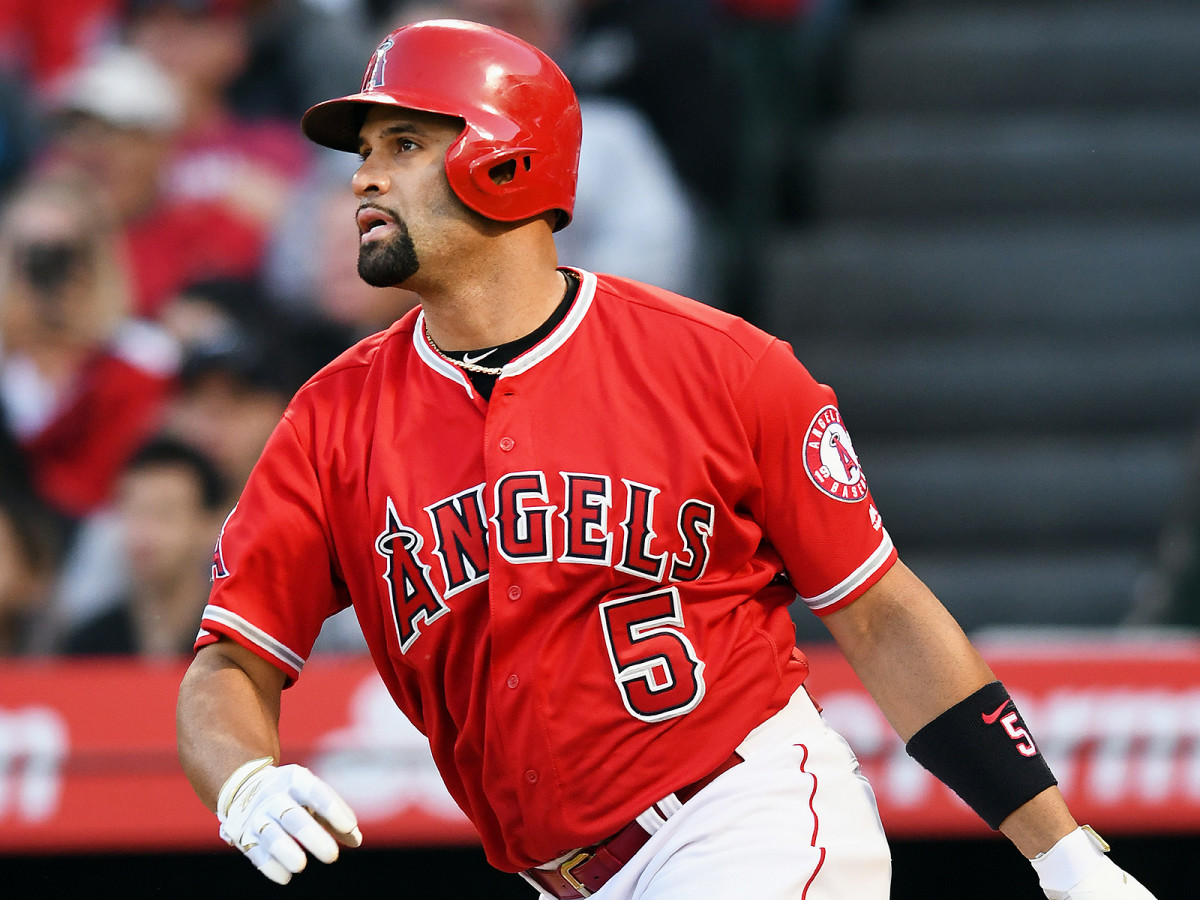
Stephanie Apstein: I found the recent news that Albert Pujols is likely 40 to be strangely comforting. Pujols’s sustained excellence had been such fun to watch, and it has been such a bummer the last few years to listen to the disdain in fans’ voices after he grounds into another double play. If he’s 38, the dropoff has been precipitous and hard to understand. If he’s 40, the timeline makes perfect sense. Maybe then we can just appreciate that we got to watch the greatest hitter of his generation play a decade and a half, even if it’s a different decade and a half than we thought.
Watch: Pablo Sandoval Pitches Perfect Ninth Inning
Michael Beller: If you go to Google and type “Albert Pujols homer,” the first autofill it offers is “off Brad Lidge.” And with good reason. This is one of those homers that reflexively forces incredulous laughter out of your mouth. It’s totally involuntary, and it happens without fail. I can’t even estimate how many times I’ve seen this homer, and I still can’t control my reaction to it.
When I read this question, this was the first moment that came to mind. Whenever Pujols is inducted into the Hall of Fame, it’ll be the first memory that pops into my head. Decades from now, when I’m telling my grandkids about the best hitters from when their granddad was young, Pujols and this homer—coupled with Brad Lidge crouching on the mound—will be as accessible in my mind as it is today. And the funny thing is that it doesn’t even count as one of the 3,000-plus hits he’ll finish with in his career.
Jack Dickey: Is everyone gonna say the three-run homer he hit off Brad Lidge in Game 5 of the 2005 NLCS? Because that’s the right answer. The Cardinals of those days were not a particularly warm and cuddly bunch—Scott Rolen and Jim Edmonds, the elder statesmen, cut menacing figures, as did the young Yadier Molina—but those Astros may have been worse. Roger Clemens, pumped full of god-knows-what, managed to throw 211 innings of 1.87-ERA ball in 2005 at age 42. I wanted to see those Astros humbled, and Lidge, with his 42-for-46-in-save-chances season, seemed a fitting vector for that humbling.
Man, Pujols smashed that ball. I’m not sure I’ve ever seen a right-handed hitter so thoroughly pulverize a hanging slider. The stadium turned so quiet so quickly. Houston still won that series, but Chicago would sweep them in the World Series, with Lidge taking losses in Games 2 and 4. It would take him a couple years, and a trade to Philly, to rediscover his form. And the Astros wouldn’t see the playoffs again until 2015. That’s the damage only a swing as mighty as Pujols’s can do.
Connor Grossman: The "proper" answer may be Pujols's moonshot off Brad Lidge, but we accept answers of all kinds in Nine Innings. That's why my favorite memory of Albert Pujols came in a nondescript extra-inning game against the Giants in 2007 when he was thrown out trying to steal home. Yes, you read that correctly.
Standing on third as the go-ahead run in the 12th inning, Pujols inexplicably tried to steal home against wild lefthander Jonathan Sanchez. He took off for the plate just as Sanchez came set and made it halfway down the line before anyone noticed. Catcher Bengie Molina popped up, furiously waiving his arms for Sanchez to throw home, and just as he did, Pujols stopped running 15 feet from the dish. He stopped. Of course, Molina then bobbled Sanchez's throw, prompting Pujols to continue his steal attempt just as Molina gathered the ball. Pujols was out easily as he half-heartedly slid with one leg into the plate. A completely inexplicable moment by a player who often did inexplicable things, but never in this light. As longtime Giants broadcaster Duane Kuiper said on the broadcast: "Just about the time you think you've seen everything, you realize you haven't." Precisely.
David Dahl is Back and Needs to be on the Fantasy Baseball Radar
Jon Tayler: The greatest moment of Albert Pujols’s career was Game 5 of the 2005 NLCS, when he ripped Brad Lidge’s soul from his body and ate it alive. You may disagree, particularly if you’re an Astros fan, Brad Lidge, or a member of Brad Lidge’s family. But for the rest of us, this was arguably the most savage home run ever hit—a breathtaking display of violence, like watching a freight train slam into a car on the tracks. It’s a miracle that Lidge wasn’t found wandering around downtown Houston in a daze after that game, glassy-eyed and trembling. It was a home run so brutal that Lidge’s career went flying off the tracks for nearly two years immediately thereafter. It’s the closest the game of baseball has ever come to a posterizing dunk. It was beautiful, and the cruelest thing of it all was that they made the Astros keep playing after that instead of letting everyone go home. At the very least, they should have stopped the game for five minutes so we all could have appreciated what Pujols did, and how utterly titanic that moment was.
Tom Verducci: My favorite moment of Albert Pujols’ career—as long as we’re talking personal memories—is sharing a batting cage with him during one of his offseason workouts near his Missouri home. It was amazing to watch him hit line drive after line drive to almost the same spot in the batting cage—what would have been to the left of where a second baseman might play – and explain what he was doing and why.
And it was cool watching him take swings off the tee with the ball set above the strike zone. Why would he do that? He explained that sometimes, such as when you need to get a runner home from third or second base, you need to be able to hit a pitcher’s pitch, rather than just waiting for your pitch. Pujols is one of the best high-ball hitters who ever lived. He will go down as one of the best hitters of all time. Only Hank Aaron hit more home runs without ever striking out 100 times in a season.
CRAIG COUNSELL REIMAGINES BULLPEN USAGE; BREWERS FOLLOW IN ASTROS' OFFENSIVE FOOTSTEPS
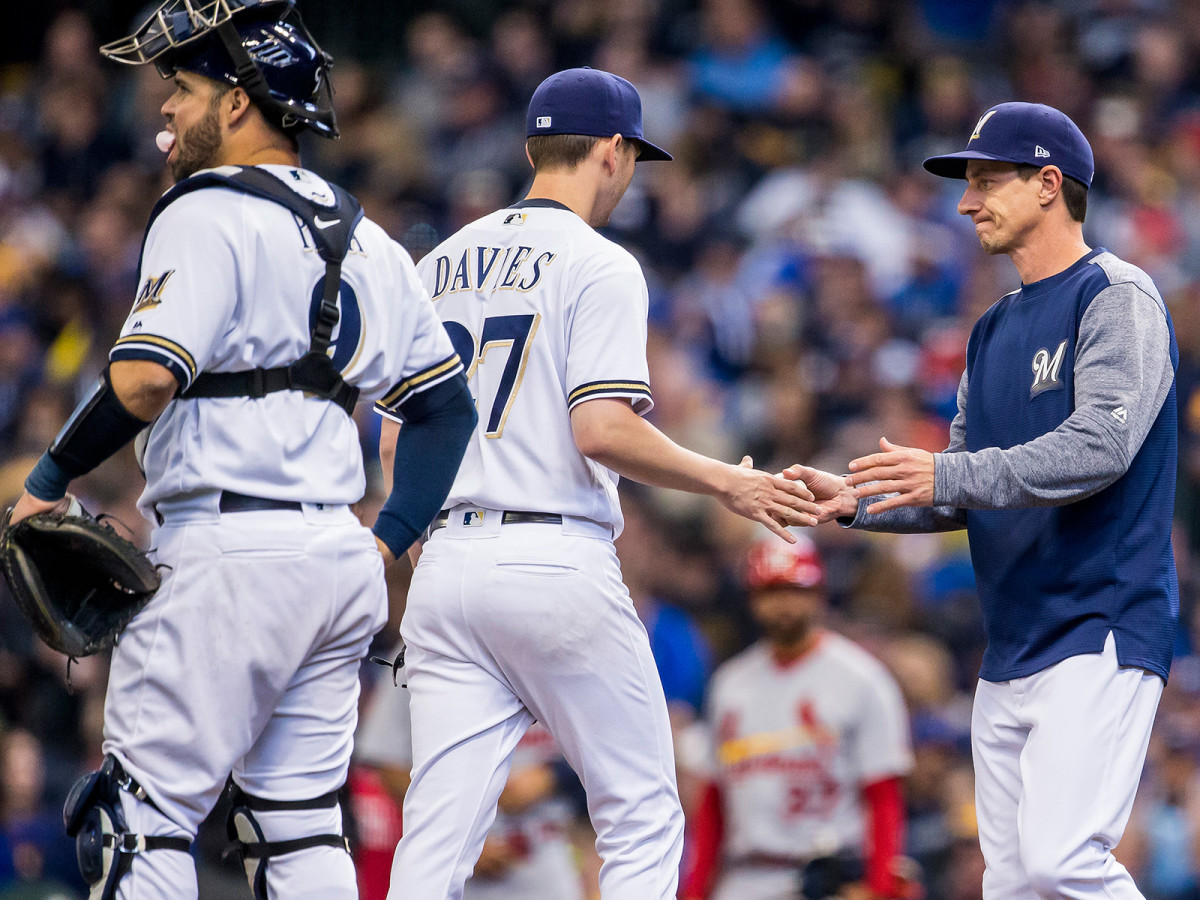
By Tom Verducci
There is a quiet revolution happening in Milwaukee. Brewers manager Craig Counsell is redefining bullpen usage—and doing so with his closer, Corey Knebel, on the disabled list.
Counsell is using what he calls his “Starter’s Closer.” We all know the game pivots today in the fifth and sixth inning—when the lineup turns over for a third time. Data heavily favors a reliever facing a batter for the first time over a starter doing so for a third time.
Most managers use their “middle” relievers in those spots, hoping to build a bridge to their Eighth Inning Guy, who can hand the ball to the Proven Closer. Jeremy Jeffress would be most manager’s idea of an Eighth Inning Guy. But Counsell deploys him as his Starter’s Closer. As soon as his starter begins to falter, and especially with runners on, Counsell goes straight to his second-best arm in the bullpen, Jeffress, rather than saving him for the eighth. He wants one of his best arms to “close” the outing of the fading starter.
Jung Ho Kang Granted U.S. Work Visa, Will Rejoin Pirates
“I think it’s such a crucial part of the game,” Counsell said. “... There’s a big difference between facing the top three in a lineup as opposed to the bottom three [which often happens in the eighth inning]. I’d say that’s become a big difference for me just in the last four years.
“Jeffress is perfect in that spot because he’s closed games and he’s used to the pressure, so he’s able to handle coming in with runners on to bail out the starter.”
Jeffress has inherited 12 runners and allowed only one of them to score. Counsell has called on him 10 times in the fifth, sixth and seventh innings.
Counsell has one more innovation, and it’s sparked by using bullpen weapon Josh Hader in a similar manner to how the Indians have used Andrew Miller. He has used Hader as early as the fourth inning. Here’s his explanation:
“If there’s a game where I know I’m going to use somebody,” Counsell said, referring to a rested reliever who needs the work, “why wait? If there’s a spot early that makes sense, I’ll use him there. Because saving a guy means there’s always a chance there won’t be a meaningful spot later.”
The Brewers are 10–0 when Counsell uses Hader. Their bullpen ended the weekend as the third best bullpen in baseball, behind only Arizona and Toronto.
***
Milwaukee has ripped a page out of the Astros’ architectural plans. Both franchises relay heavily on analytics, and both originally built power-laden lineups chock full of strikeouts. Number crunchers never minded strikeouts; they’re just another out, right?
(Paradoxically, teams crave them from pitching staffs to depress offense, but don’t see them as a detriment to offense.)
Plan in the Works for a Gondola That Would Take Fans to Dodger Stadium
The Astros finally had enough, however, of watching empty at-bats between home runs from the likes of Colby Rasmus, Jason Castro, Luis Valbuena and Carlos Gomez, all of who were gone from their 2016 team. They added Brian McCann, Josh Reddick, Carlos Beltran and Norichika Aoki—all tougher at-bats. Houston improved from the fourth-most strikeouts in baseball to the fewest strikeouts, and won the World Series.
Milwaukee has learned the same lesson, and primarily because of the acquisitions of Lorenzo Cain and Christian Yelich, is putting more balls in play. Check out this improvement:
Brewers Strikeouts
| Strikeout Percentage | MLB Rank |
|---|---|---|
2016 | 25.5% | 30 (Broke MLB Record) |
2017 | 25.6% | 30 (Broke MLB Record) |
2018 | 23.1% | 17 |
“It was capping our offense,” Counsell said about the high strikeout rate. “We were scoring runs, but it put a limit on us offensively. You can get into a debate about it, but it’s limiting to me when you don’t put the ball in play. It was like a cap on our offense.”
APPRECIATING JONNY VENTERS'S LONG, PAINFUL, AND UNPRECEDENTED JOURNEY BACK TO THE BIG LEAGUES
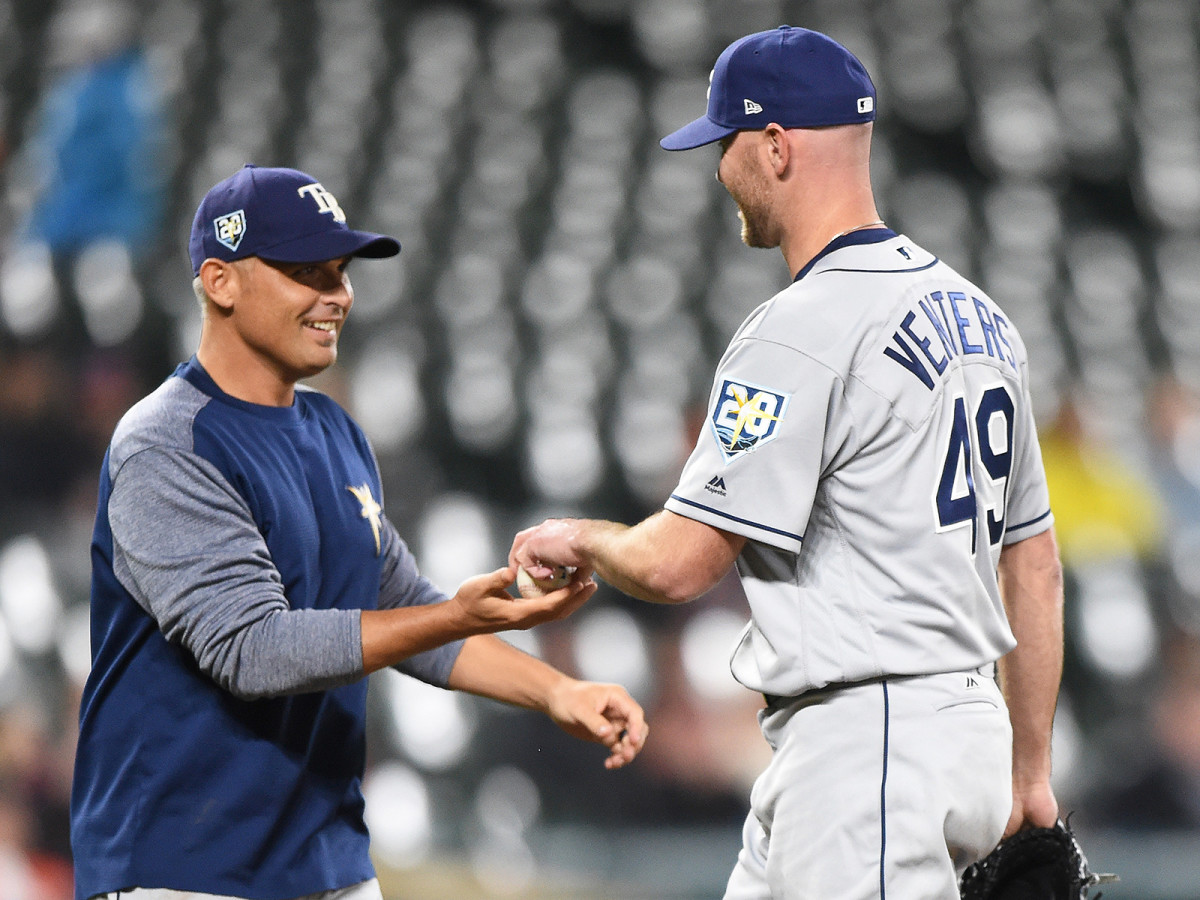
By Stephanie Apstein
One of the worst parts of undergoing Tommy John surgery is that everyone expects it to work. You’ll be good as new! Everybody has this these days. The success rate is, like, 85%. Some guys actually throw harder afterward. In the 44 years since surgeon Frank Jobe plucked a tendon from right forearm of Yankees pitcher Tommy John and threaded it through his left elbow, we have come to view the procedure as the equivalent of a pulled hamstring. It’s a pain, sure, but if you do what you’re told, you’ll be fine.
This is a problem because it makes setbacks your fault. And most players will encounter setbacks. Some—far more than that widely quoted 15% figure, as sabermetrician Jon Roegele has established with his meticulously updated Tommy John Surgery List—will never return at all. When I profiled several of these Tommy John casualties in 2014, I heard over and over that the physical pain paled in comparison to the emotional anguish of deciding when to give up. How do you know when all is lost?
All this makes the story of Jonny Venters, who induced a groundout for the Rays on Wednesday, the best in baseball so far this year. He had his first UCL reconstruction as a 20 year old in Class A in 2005. He was dismayed but not discouraged, and he made it back in April 2007. That repair lasted until spring training in 2013, when he felt tightness—different from the telltale pop from the first time, so he was optimistic the outcome would be different. It wasn’t. Five outings into his rehab assignment a year later, he tore it for a third time.
After Three Tommy John Surgeries, Jonny Venters Back in Majors
“I think I all but made my mind up I wasn't going to do it again,'' Venters told the Tampa Bay Times last week. "And I spoke with the doctors and my family, and kind of everybody thought it was a good idea to do it again. So I thought I felt like if everybody that I cared about thought that way, that I'd be stubborn to not try it again. So here I am.”
Here he is, in a major league clubhouse, wearing a major league uniform, on a major league mound. Venters admitted that this outing carried almost as much emotional heft as his 2004 debut. His last appearance before Wednesday came in the 2012 NL Wild Card Game for the Braves. Third baseman Chipper Jones played that day. He will be inducted into the Hall of Fame this July. Fans snapped photos on their iPhone 4s. Venters had an 11-month-old; he’s now a 33-year-old father of three.
A comeback like this is unprecedented: Roegele identifies 89 players who have undergone the procedure as many as two times. Fifty played again at any level. No one but Venters, as far as anyone knows, has even had a third UCL reconstruction, let alone returned to the major leagues afterward. Venters has made history. Now he gets to pitch.
QUICK HITS ON THE NATIONAL LEAGUE WEST
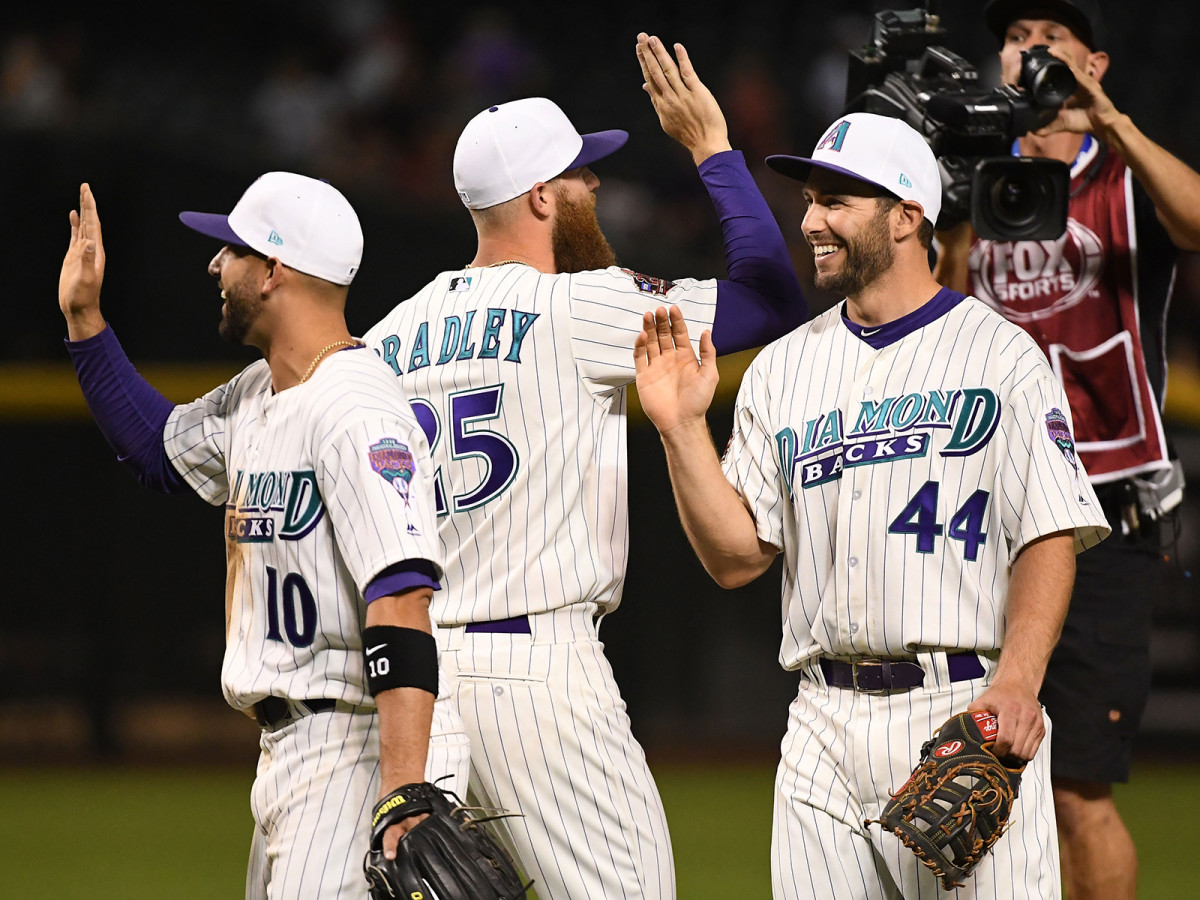
By Connor Grossman
1. How impressive have the Diamondbacks been this season? After winning yet another series this weekend (this one over the struggling Nationals), the team tweeted that they’re the first National League squad since 1907 to start the year with nine straight series wins. Arizona hasn’t lost consecutive games yet and has four winning streaks of three games or longer. In other words, baseball’s best team might be out in the desert.
2. A sentence rarely written: The Rockies’ offense is struggling. The team scored two runs in a series loss to the last-place Marlins, and relief pitcher Antonio Senzatela knocked in one of them. Colorado’s .224 team average is nearly worst in the National League, ahead of only Miami. Nolan Arenado and Charlie Blackmon continue to anchor the lineup, combining for 13 home runs, 28 RBI and a .295 average between the two.
Yawkey Way Outside Fenway Park Changed to Jersey Street Over Racist Past
3. Since starting his Giants career with seven hits in 47 at-bats (.149), Evan Longoria is hitting .333 with five home runs and has San Francisco trending in the right direction of late. The Giants are still longshots to make the postseason—especially in a division with three playoff teams from last year—but are still fluttering around .500 while waiting out Madison Bumgarner’s return from a fractured pinkie.
4. If one day can encapsulate an entire month, Sunday offered that for the Dodgers. The afternoon began with manager Dave Roberts proclaiming his club will finish the year as NL West champions, and ended with Roberts removing young slugger Cody Bellinger for not hustling and a loss to the Giants for the third time in four games.
5. The Padres still don't look close to contending for their first postseason berth since 2006. But they have provided entertaining glimpses in the first month of this season, especially if blowouts are your thing. San Diego has already scored double-digit runs three times this season after only doing so four times last year. Who’s leading the offense, you’re wondering? Household names like Christian Villanueva and Franchy Cordero, of course.
HOW THE METS SHOULD HANDLE MATT HARVEY
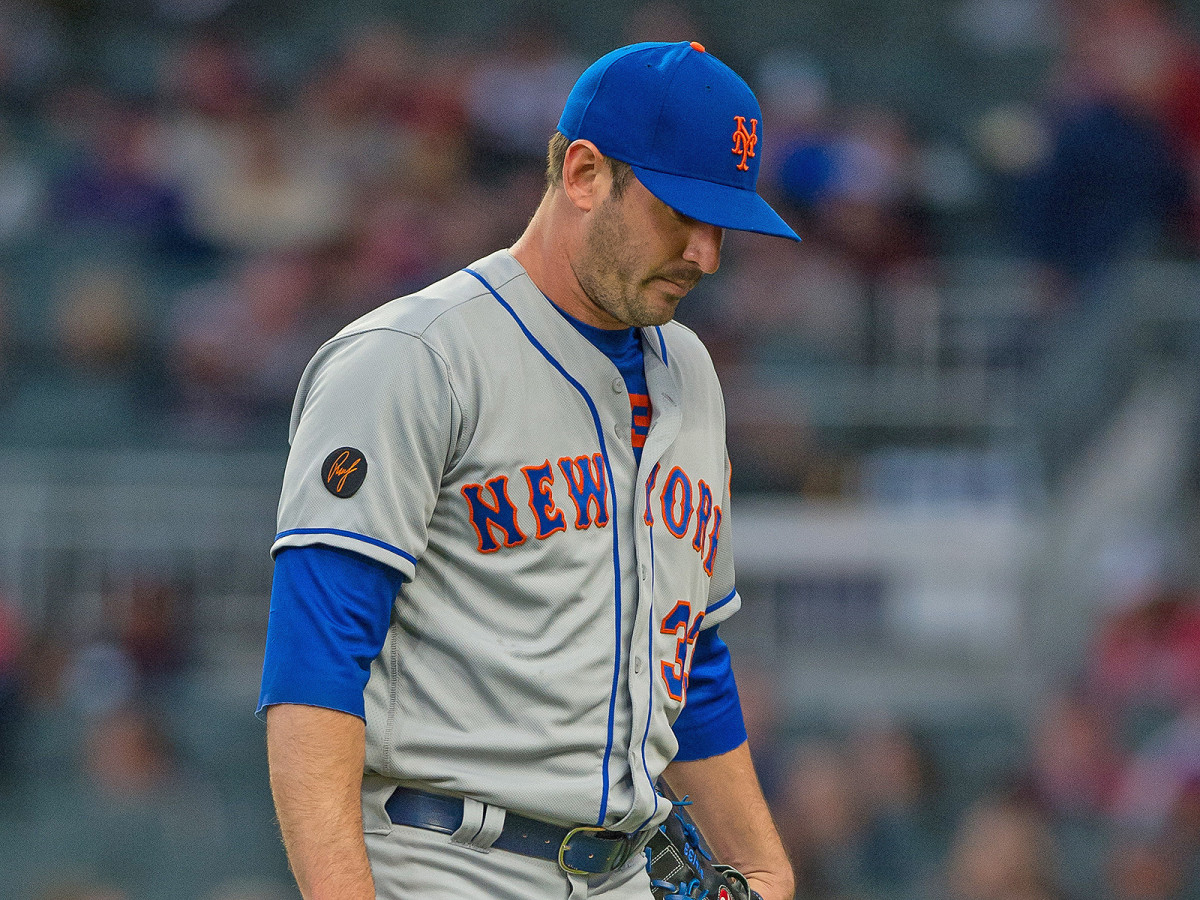
By Jon Tayler
On the surface, the Mets’ Matt Harvey question—what to do with a surly pitcher who lost what made him effective—has an easy answer: Get rid of him. It’s mildly surprising that hasn’t already happened.
Harvey’s fastball, which once hummed in at 96 mph, now limps along at 91–92. As that pitch collapsed, hitters have quickly figured it out: Opponents’ batting average on that pitch jumped from .247 in 2015 to .325 in ’16, .330 last year, and .307 this season. A fastball-first pitcher, Harvey had nothing else to lean on when that pitch went south; never a command-and-control type, he can’t succeed with diminished velocity. The numbers prove he hasn’t: a 6.00 ERA in 24 innings, just 19 strikeouts in that span, and five homers allowed, as well as a demotion to the bullpen that he didn’t take in stride.
For that, blame the thoracic outlet syndrome (TOS) surgery that robbed Harvey of most of the ’16 and ’17 seasons and that has ruined countless careers before his. There’s no need to dig much further to find reasons for why Harvey has come unglued. His attitude, never the best and deteriorating alongside him, doesn’t help, but his R-rated grouchiness or refusal to banter with the New York media aren’t why his fastball fools no one. Injuries come for every pitcher; in Harvey’s case, the TOS finished what the torn elbow ligament started back in 2013. (It probably didn’t help that, in Harvey’s first season back from Tommy John surgery, he threw 216 innings across the regular season and playoffs—well beyond the 180-inning limit he was supposed to adhere to that year.)
Mets' Matt Harvey on Not Talking to Media: 'I Have Nothing to Say to You Guys'
The hope for manager Mickey Callaway was likely that Harvey’s compromised stuff could play up in relief, but that hasn’t happened. His fastball sat at 94 in his first appearance out of the bullpen on April 24 against the Cardinals, but he still allowed two hits, a walk and a run in two innings. While he got two strikeouts, his 35 offerings resulted in only three swings and misses. In Harvey's next time out, against the Padres three days later, his velocity sagged to 92 as he allowed a solo home run and a walk in one inning—and, worst of all, saw batters swing through none of his 20 pitches.
So what’s left? Harvey can’t be trusted to handle high- or medium-leverage situations right now, leaving him as a long reliever who eats the outs that don’t matter. Maybe with more time and exposure, he can turn himself into a better reliever, but it’s hard to see his ceiling going very high.
Ironically, Harvey was pulled from the Mets’ rotation just as it started to fall apart. Veteran lefty Jason Vargas was shelled in his first start of the year; young southpaw Steven Matz is woefully inconsistent and will miss his next start with a bad back; and righty Zack Wheeler has velocity but not much else. But is the current version of Harvey a better option than anyone in that trio?
The Mets will keep running Harvey out there, hoping that he can unlock something in relief that will heal his fastball, or at least prop it up. But the free agent-to-be feels like a sunk cost. His trade value is zilch, and as his testy responses to the bullpen and reporters show, he’d be best served in a new environment, free of his past results and the expectations that haunt him. As the saying goes: If you love something, set it free.
100 WORDS ON ... RONALD ACUÑA'S FIRST MAJOR LEAGUE HOME RUN
By Michael Beller
It took only six plate appearances for Ronald Acuña to leave the yard for the first time. Earlier in this column, I referenced the brand of homers that make you laugh. Check out this hilarious beauty. Now that’s how you enter the big leagues as advertised. With one swing, the 20-year-old announced his arrival and showed what happens when you make a mistake against him over the middle of the plate. The Braves are excelling with him in the lineup, and just might be starting their future earlier than expected. Acuña and his hilarious homers are at the center of it all.
